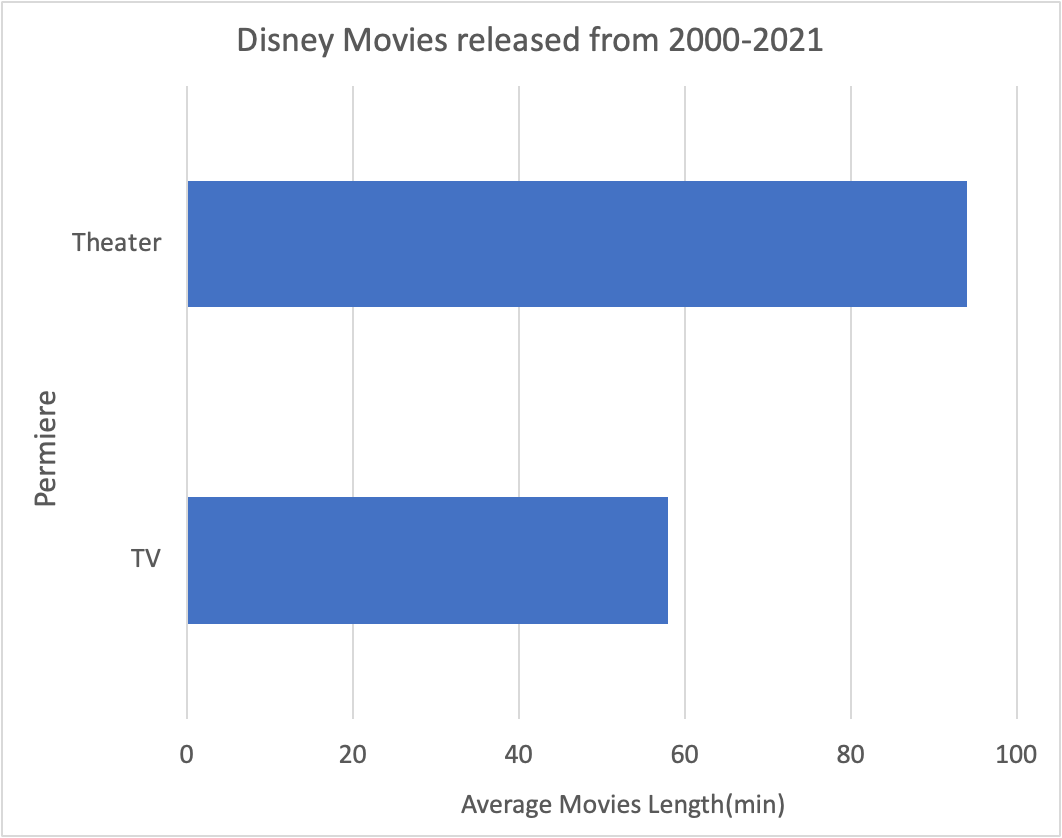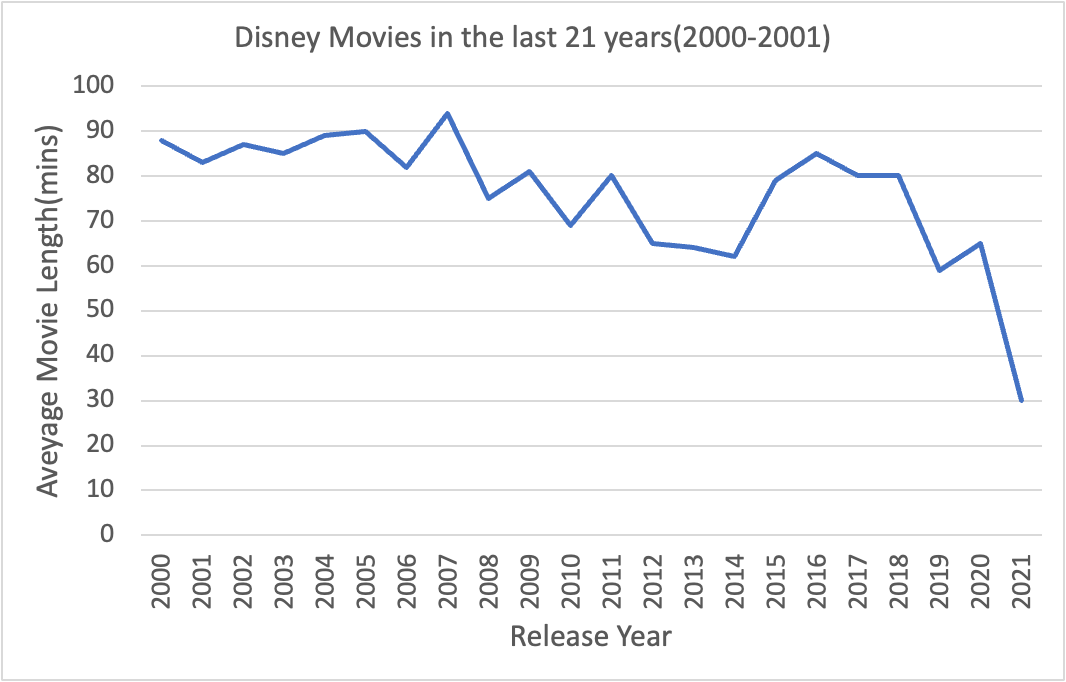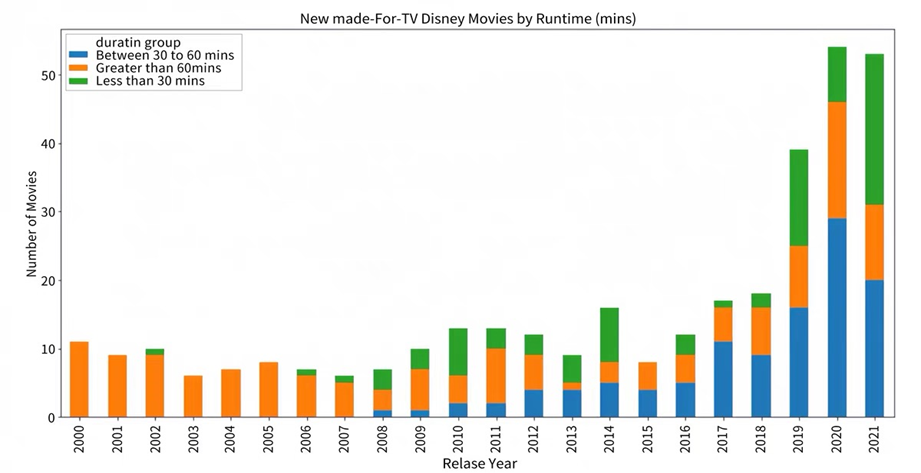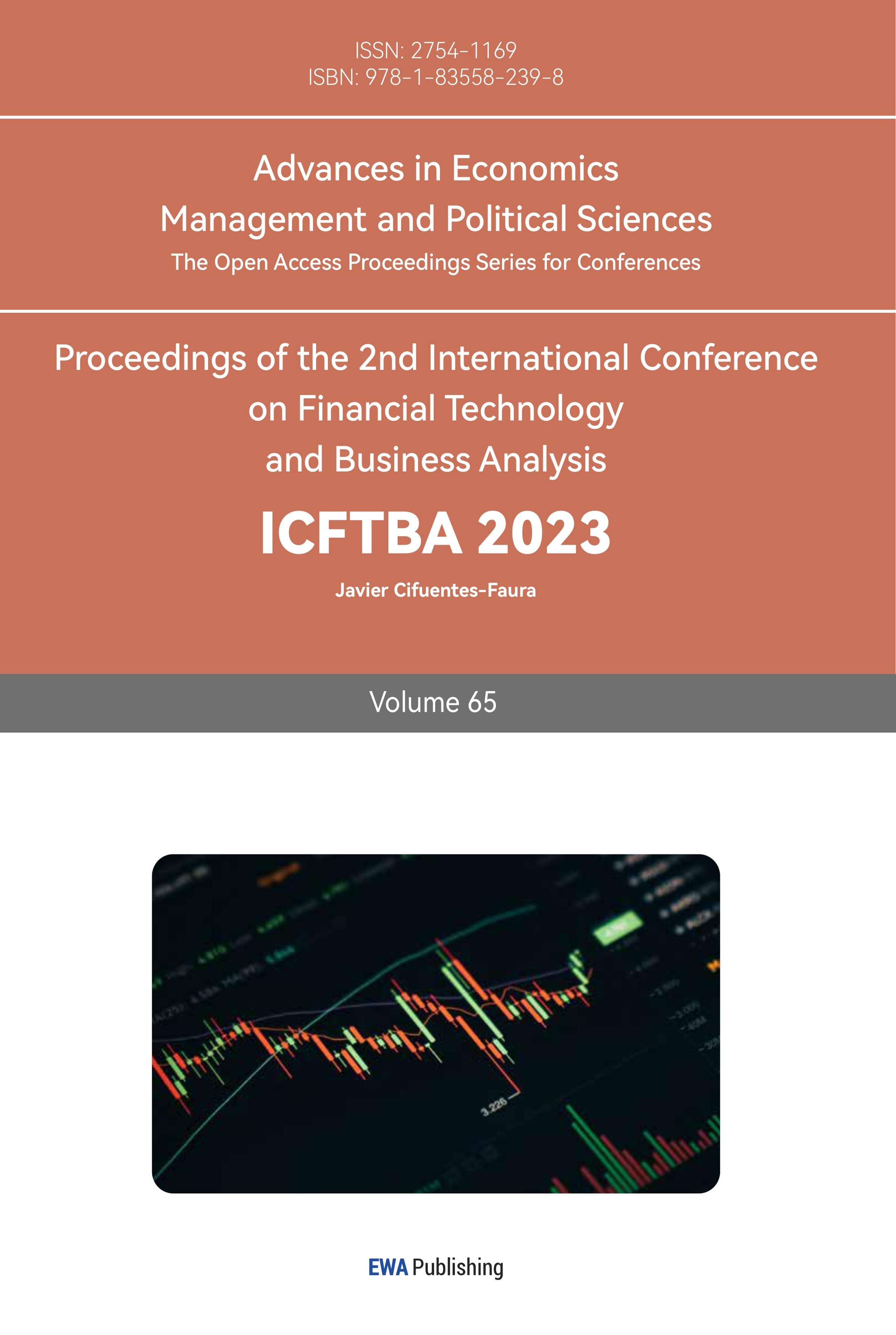1. Introduction
Disney movies, a hallmark of American popular culture, have exerted an enduring influence on global entertainment and continue to captivate audiences of all ages. Since the release of "Snow White and the Seven Dwarfs" in 1937, Disney has been at the forefront of animation and storytelling, shaping the very landscape of cinematic artistry [1]. Besides that, Disney movies deal with themes of friendship, family, courage, and dreams, conveying moral values and coming-of-age stories that appeal to audiences of all ages. These studies span a wide array of topics, offering insights into the cultural, historical, economic, and artistic dimensions of Disney's cinematic legacy. Disney's storytelling prowess is at the heart of its appeal. As noted by individuals, the narratives woven in Disney movies often reflect and respond to the socio-cultural contexts of their times, serving as a barometer for shifting societal norms. From the classic fairy tales of "Cinderella" and "Sleeping Beauty" to the modern narratives of "Frozen" and "Zootopia," Disney films have evolved in both form and content [2].
Moreover, the technological innovations pioneered by Disney have revolutionized animation and film production. Disney's groundbreaking use of the multiplane camera in "Pinocchio," a technological marvel that pushed the boundaries of animation realism [3]. Disney's foray into computer-generated imagery (CGI), opened new avenues for storytelling, as evidenced by the groundbreaking success of "Toy Story" [4]. Beyond their artistic contributions, Disney movies have been a source of cultural discourse, particularly regarding representation and diversity. examines the depiction of gender and race in Disney princess films, highlighting the evolution from passive damsels to empowered heroines [5]. The economic and business dimensions of Disney's media empire have also garnered attention from scholars. explores the strategic acquisitions that have fortified Disney's global media dominance [6]. while people analyze the synergy between Disney's theme parks and film franchises, examining how both reinforce and complement each other [7]. On November 12th, 2019, Disney+ made its debut, using a new era of streaming entertainment with an extensive library of movies and television series [8]. This digital platform, however, is not just any streaming service; it boasts exclusive access to the enchanting worlds of Disney, Marvel, Pixar, Star Wars, and National Geographic. The vast repository of content available on Disney+ from 2019 to 2021 presents a unique opportunity to delve into the magical realm of Disney movies, particularly those released between the years 2000 and 2021. The analysis of Disney movies during this timeframe is not only timely but also illuminating. Schickel suggests that Disney movies have often reflected and influenced societal values, serving as both mirrors and windows in the culture [9]. This period saw the evolution of storytelling, characters, and themes in Disney movies, encompassing issues of representation, diversity, and the shifting dynamics of gender roles.
This essay attempts to synthesize the vast literature on Disney films and provide an in-depth study of their cultural, artistic, economic, and social significance. By delving into the different categories as well as subdivisions of Disney's ever-evolving films, the study aims to shed light on how the development of Disney films relates to people's preferences and how it has expanded the influence of Disney films economically as well as commercially.
2. Methods
2.1. Data Sources
The data for this literature is collected from the Kaggle website, which was compiled by Shivam Bansal from the listing of all the Disney movies and TV shows available on Amazon Prime, along with details such as cast, directors, ratings, release year, duration, etc.
2.2. Data Dictionary
The data has close to 1300 movies and TV shows available on their platform, as of mid-2021, they have over 116M Subscribers globally. In the comprehensive exploration of Disney films and television content. A dataset has been curated, encompassing several pivotal attributes. These characteristics aim to shed light on various facets of the entertainment giant's portfolio. At the foundation of the dataset is the `show_id`, a unique identifier ensuring the accurate representation of each distinct piece of content. The `type` field delineates the nature of the content – be it a film or a television series – granting insights into the distribution of Disney's content offerings. Critical descriptors such as the title, director, main cast, and production country are meticulously cataloged under `title`, `director`, `cast`, and `country` fields respectively. These not only furnish fundamental details about each title but also pave the way for nuanced discussions around predominant directors or actors within Disney's oeuvre. The temporal dimension of the dataset is addressed through the `date_added` and `release_year` fields. The former indicates when a title was incorporated into Disney+, while the latter reveals the original year of release. Such chronological data can be instrumental in tracing the evolution of Disney's content repository. To appreciate the intended audience and scope of the content. Attention is then directed to the `rating` field, which signifies the target demographic. Furthermore, the `duration` metric provides a gauge of the length of movies or the number of seasons in a series. By examining the genre information within the `listed_in` field, one can decipher the content distribution strategies across diverse genres. Conclusively, the `description` field offers succinct summaries of each title, facilitating an understanding of the narrative arc and thematic essence. In sum, this dataset endows us with a panoramic view of Disney's content strategy. From granular insights into individual titles to broader trends in content distribution, a robust foundation has been established for the ensuing analysis [10].
2.3. Data Dictionary
In the foundational phase of the research, the Disney movie dataset was meticulously imported and cleansed. The focus was initially directed to entries classified as 'Movie' and exclusively on films released after the year 2000, ensuring the modern relevance of the study. Further streamlining was accomplished by eliminating extraneous columns that didn't directly align with the research objectives. Transformations were also applied to the `duration` and `rating` columns, involving data type conversions and addressing missing values. Such diligent preprocessing ensured a refined and accurate dataset, paving the way for subsequent in-depth analyses.
3. Results and Discussion
3.1. Descriptive Data Analysis
In the exploration, to delve into the relationship between the average length of Disney movies and their ratings, further groupings and organization of the dataset were orchestrated. The initial focus was on the `rating` and `duration` columns, with data being grouped based on the `rating`. Subsequently, the average duration of movies for each rating category was computed and presented in descending order of length. To visually represent these findings, the bar chart was plotted where the y-axis depicts the average movie length in minutes, and the x-axis represents the rating categories. This visualization effectively showcases the average duration of Disney movies across different ratings from the years 2000 to 2021 (Figure 1).

Figure 1: Disney Moves released from 2000 to 2021
To further the exploration, the research categorized Disney movies into two premiere types: 'TV' and 'Theater', based on their ratings. For instance, ratings like 'TV-14', 'TV-PG', and similar were classified as 'TV', while the rest fell under 'Theater'. Next, the research calculated the average duration for movies under each premiere type and visualized this using a horizontal bar chart. The x-axis represents the average movie length, and the y-axis denotes the premiere type. This allows a clear comparison of average movie durations between different premiere types from 2000 to 2021 (Figure 2).

Figure 2: Disney Moves released from 2000 to 2021
In examining the relationship between the runtime of Disney movies and their attributes, the study initially categorized movies into 'TV' or 'Theater' based on their ratings. Through this classification, an intriguing observation emerged: movies that premiered in theaters have a notably longer average runtime compared to those crafted for television. Delving deeper to understand the correlation between runtime and movie attributes, movies were further categorized by their specific ratings, and the average runtime for each category was calculated. The results indicated that movies tailored for younger audiences, such as 'TV-Y' and 'TV-Y7', possess the shortest average runtimes. From these insights, several conclusions can be drawn Movies that premiere in theaters tend to have longer runtimes, possibly due to the immersive big-screen experience and potential for high return on investment. In contrast, movies made for television might have shorter durations due to advertising constraints and broadcast scheduling. Furthermore, the shorter durations of movies for younger viewers might be designed considering their limited attention spans, necessitating a faster pace and more compact plot to engage them.
In the quest to understand the evolution of Disney movie durations over the past two decades, the average lengths of these films were analyzed based on their release years, specifically focusing on films released between the years 2000 and 2021. The analysis began by grouping the movies by their respective release years and then calculating the average runtime for movies in each year. This data was then visualized in a line chart, allowing a clear view of trends across the span of 21 years. The x-axis represented the release year while the y-axis denoted the average movie length in minutes. From the graph, it becomes possible to discern patterns or shifts in movie lengths over the specified period, offering insights into Disney's cinematic strategy in terms of content curation.

Figure 3: Disney Moves by premium type
For Figure 3, the research found that over the past 21 years, Disney movies have showcased evolving trends in their runtime. While there is a noticeable fluctuation in the average length of movies released from 2000 to 2021, the distinct division between TV and theater premieres is evident. Films designed for theater releases typically have longer runtimes compared to those made for television. This could be attributed to traditional cinema's storytelling demands and production values compared to made-for-TV content. Additionally, films tailored for younger audiences generally possess shorter durations, possibly to cater to shorter attention spans. As media consumption patterns continue to evolve, so does the strategic approach of studios like Disney in tailoring content based on its premiere platform and target audience.
3.2. Discussion
Figure 4 shows that upon delving deep into the durations of Disney movies, the ten shortest films were specifically analyzed. By ranking them based on their duration, it became evident which films had the least runtime. The study considered the films' titles, ratings, premiere types, release years, and durations. A salient finding from this analysis revealed that most of the top 10 longest Disney movies premiered in theaters, emphasizing a strategic move by Disney to invest more screen time for larger theatrical audiences. In contrast, the 10 movies with the shortest running time were predominantly short films that premiered on television. This distinction underscores the inherent differences in content creation for the two platforms, with TV often catering to shorter attention spans or specific broadcast slots, while theater productions aim for a more immersive and extended experience.
The analysis expanded further by categorizing movies based on their runtime. Three distinct categories were created for assessing the movie duration: movies lasting 'Less than 30 mins', those spanning 'Between 30 to 60 mins', and those running for 'Greater than 60 mins'.
To provide a focused lens on the made-for-TV segment, only the movies premiered on TV were considered for this phase of the analysis. A detailed yearly breakdown reveals the frequency of movies that fit into each of the duration categories, based on their release year.
Observing the stacked bar chart representation, it becomes clear that Disney's approach toward the duration of its TV content has evolved over the years. Certain periods depict a preference for shorter films, potentially mirroring the industry trends, consumer attention spans, or the competitive landscape at the time. In some years, the inclination seems towards producing movies that stretch beyond the 60-minute mark, perhaps catering to more comprehensive storytelling or special programming events.
Interestingly, there is also a noticeable shift in the production of medium-length content ('Between 30 to 60 mins'). This possibly indicates a balance Disney might be trying to strike between storytelling depth and keeping the audience engaged without overwhelming them, particularly on the TV platform.
In conclusion, understanding these patterns provides valuable insights into Disney's content strategy for television. The adaptable nature of their content length decisions showcases their responsiveness to both audience preferences and the ever-shifting dynamics of the entertainment industry (Figure 4).

Figure 4: New Made-For-TV Disney movies by the runtime
4. Conclusion
Throughout the comprehensive exploration of Disney's cinematic data, certain discernible patterns and trends have been illuminated. Historically, Disney films released in theaters consistently command a longer run time on average, which not only underscores the studio's investment in crafting expansive narratives for the big screen but also highlights audiences' sustained appetite for lengthier cinematic experiences in theaters. Remarkably, even amidst the rapidly evolving landscape of the film industry, the average run-time of these theatrical releases has managed to remain relatively stable over the last 21 years. This showcases Disney's commitment to delivering extensive and immersive tales that align with the expectations of theatergoers.
In stark contrast, there has been a noticeable decline in the average run-time of Disney's Made-For-Television movies. This trend can be primarily attributed to the surge in the production of short films, which cater to the evolving consumption habits of TV and digital audiences, favoring shorter, bite-sized content. This shift not only reveals Disney's adaptive strategies in content creation for diverse platforms but also highlights the nuanced differences in audience expectations across mediums.
Further granularity in the data reveals another intriguing facet: Disney's Made-For-Television films designed for younger children predominantly showcase shorter run times. This suggests a deliberate content strategy tailored to the attention spans and consumption patterns of this demographic, affirming Disney's commitment to producing content that is both engaging and age-appropriate.
In synthesis, Disney's cinematic ventures, whether designed for the theater or television, exhibit a deep understanding of their target audience, medium specifications, and prevailing industry trends. Their adaptability and keen market acumen ensure that they remain at the forefront of the entertainment industry, crafting content that resonates with diverse audiences across various platforms.
References
[1]. Palmer, J.P. (2000) Animating cultural politics: Disney, race, and social movements in the 1990s. University of Michigan.
[2]. Weeks, J. (2011) Fairies, fairy tales, and the development of British poetics. University of Notre Dame.
[3]. Telotte, J.P. (2010) The mouse machine: Disney and technology. University of Illinois Press.
[4]. Flanagan, M. (2012) Hollywood Calling: Cinema’s Technological Address. Bakhtin and the Movies: New Ways of Understanding Hollywood Film, Journal of Vacation Marketing.
[5]. Hine, B., et al.(2013) The rise of the androgynous princess: Examining representations of gender in prince and princess characters of Disney movies released 2009–2016. Routledge.
[6]. Schernhammer, E., et al. (2013) Rotating night-shift work and Lung cancer risk among female nurses in the United States. American Journal Epidemiology, 178(9), 1434-1441.
[7]. Wong, K.K.F. and Cheung, P.W.Y. (1999) Strategic theming in theme park marketing. Journal of Vacation Marketing, 5(4), 319-332.
[8]. Rehman, M. (2021) Dream Bigger, Disney: Exploring the Walt Disney Company’s Future Role in Planetary Politics. The University of Toronto's Journal of Sustainable Development, 1(1), 113-130.
[9]. Schickel, R. (2019) The Disney version: The life, times, art and commerce of Walt Disney. Simon & Schuster.
[10]. Rao, S.G. (2008) Typological Experience (Strategy) and Development Strategy of Chinese Film. Contemporary Film, 7.
Cite this article
Wang,Z. (2023). Research of Influence Factors on Disney Movies. Advances in Economics, Management and Political Sciences,65,135-141.
Data availability
The datasets used and/or analyzed during the current study will be available from the authors upon reasonable request.
Disclaimer/Publisher's Note
The statements, opinions and data contained in all publications are solely those of the individual author(s) and contributor(s) and not of EWA Publishing and/or the editor(s). EWA Publishing and/or the editor(s) disclaim responsibility for any injury to people or property resulting from any ideas, methods, instructions or products referred to in the content.
About volume
Volume title: Proceedings of the 2nd International Conference on Financial Technology and Business Analysis
© 2024 by the author(s). Licensee EWA Publishing, Oxford, UK. This article is an open access article distributed under the terms and
conditions of the Creative Commons Attribution (CC BY) license. Authors who
publish this series agree to the following terms:
1. Authors retain copyright and grant the series right of first publication with the work simultaneously licensed under a Creative Commons
Attribution License that allows others to share the work with an acknowledgment of the work's authorship and initial publication in this
series.
2. Authors are able to enter into separate, additional contractual arrangements for the non-exclusive distribution of the series's published
version of the work (e.g., post it to an institutional repository or publish it in a book), with an acknowledgment of its initial
publication in this series.
3. Authors are permitted and encouraged to post their work online (e.g., in institutional repositories or on their website) prior to and
during the submission process, as it can lead to productive exchanges, as well as earlier and greater citation of published work (See
Open access policy for details).
References
[1]. Palmer, J.P. (2000) Animating cultural politics: Disney, race, and social movements in the 1990s. University of Michigan.
[2]. Weeks, J. (2011) Fairies, fairy tales, and the development of British poetics. University of Notre Dame.
[3]. Telotte, J.P. (2010) The mouse machine: Disney and technology. University of Illinois Press.
[4]. Flanagan, M. (2012) Hollywood Calling: Cinema’s Technological Address. Bakhtin and the Movies: New Ways of Understanding Hollywood Film, Journal of Vacation Marketing.
[5]. Hine, B., et al.(2013) The rise of the androgynous princess: Examining representations of gender in prince and princess characters of Disney movies released 2009–2016. Routledge.
[6]. Schernhammer, E., et al. (2013) Rotating night-shift work and Lung cancer risk among female nurses in the United States. American Journal Epidemiology, 178(9), 1434-1441.
[7]. Wong, K.K.F. and Cheung, P.W.Y. (1999) Strategic theming in theme park marketing. Journal of Vacation Marketing, 5(4), 319-332.
[8]. Rehman, M. (2021) Dream Bigger, Disney: Exploring the Walt Disney Company’s Future Role in Planetary Politics. The University of Toronto's Journal of Sustainable Development, 1(1), 113-130.
[9]. Schickel, R. (2019) The Disney version: The life, times, art and commerce of Walt Disney. Simon & Schuster.
[10]. Rao, S.G. (2008) Typological Experience (Strategy) and Development Strategy of Chinese Film. Contemporary Film, 7.









